Last updated on March 14, 2024
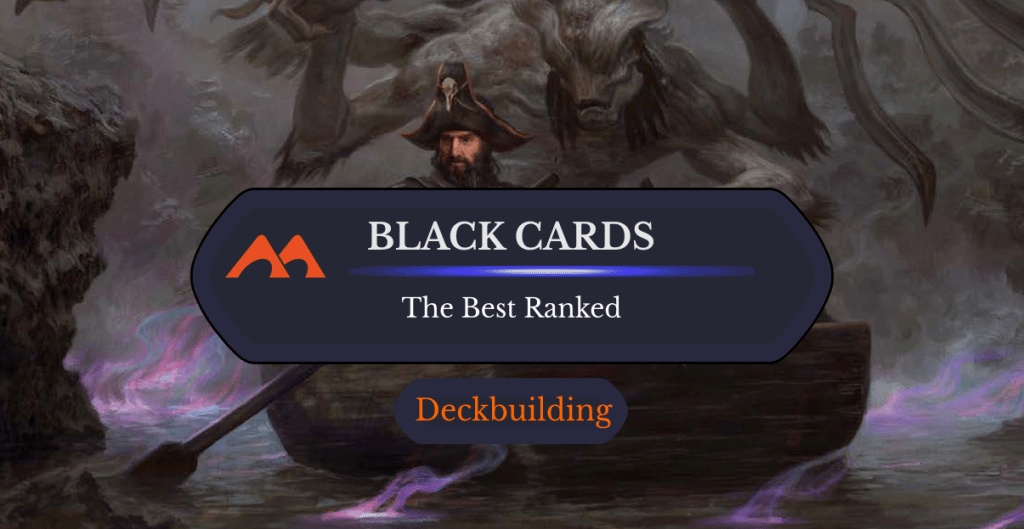
Demonic Tutor | Illustration by Zack Stella
Ah, the color black. A color that will do anything to get extreme power, and a crucial color in Constructed MTG formats right from the beginning of the game with its discards, removals, card draws, and impactful demons. Dimir () was an extremely competitive Constructed color pair for many years, mono-black decks had their time in the sun several times, and there was even a period known as “Black Summer” when black decks dominated the scene.
Today I'm showing black in all its splendor, highlighting the best black cards that MTG has to offer. I want to especially consider the historical value of these cards in Constructed decks, whether in Commander or in Legacy/Vintage.
Without further ado, let's see what I have for you today!
What Are Black Cards in MTG?

Doomsday | Illustration by Noah Bradley
Black cards are, simply put, cards that only require black mana (the beloved skull symbols) to cast. I want to stick with the color identity for a black commander and only rank cards that are legal in a black Commander deck. That means cards like Toxrill, the Corrosive are out since they have blue mana in the activation cost. That also means no gold or hybrid cards that contain black mana.
Flavor-wise, black cards show the boundaries of what wizards and spell cards can do in order to obtain power and achieve their goals. You’ll see themes like paying life to cast spells, sacrificing creatures to get their energy, and outright killing the enemy. It’s common to see cursed monsters or artifacts in black too. Typical creature tribes in black are zombies and demons, but also rogues, thieves, and assassins.
#34. Doomsday

Doomsday is the weirdest card in this list, but it’s powerful and a one-card combo. You get to trade in your library and graveyard to turn your next (last) five draws into your best. How you’re going to use Doomsday varies with the format (Cube, Vintage, EDH), but you’ll usually want a card like Laboratory Maniac or Thassa's Oracle and draw spells like Gush or Gitaxian Probe.
#33. Bolas's Citadel
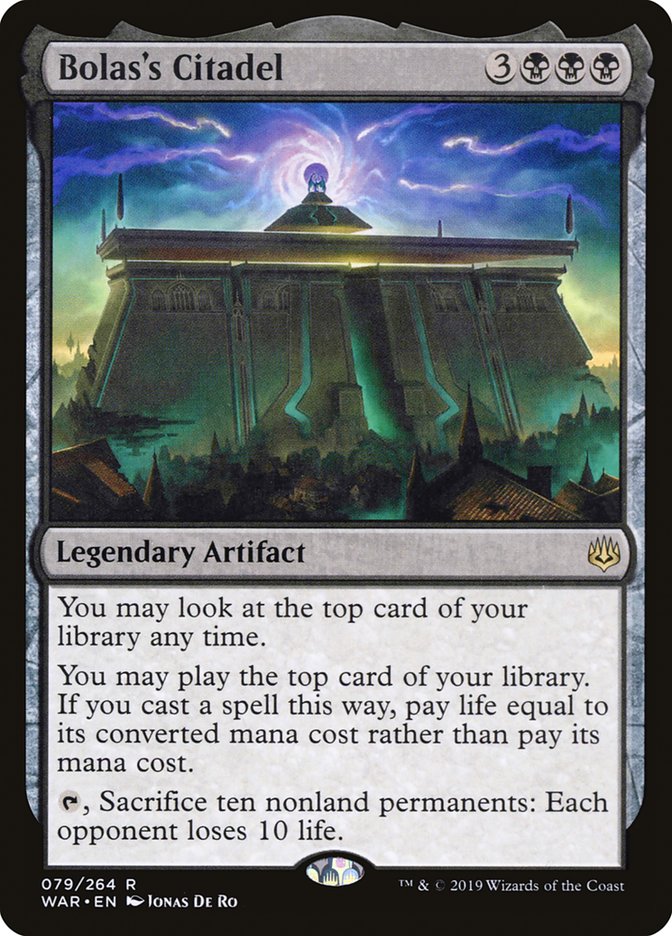
Bolas's Citadel is a fixed Ad Nauseam, so to speak. It gives you more control over what you play since you can look at the top card, and since it’s an artifact, you can cheat it into play with cards like Tinker or Daretti, Scrap Savant.
#32. Dauthi Voidwalker
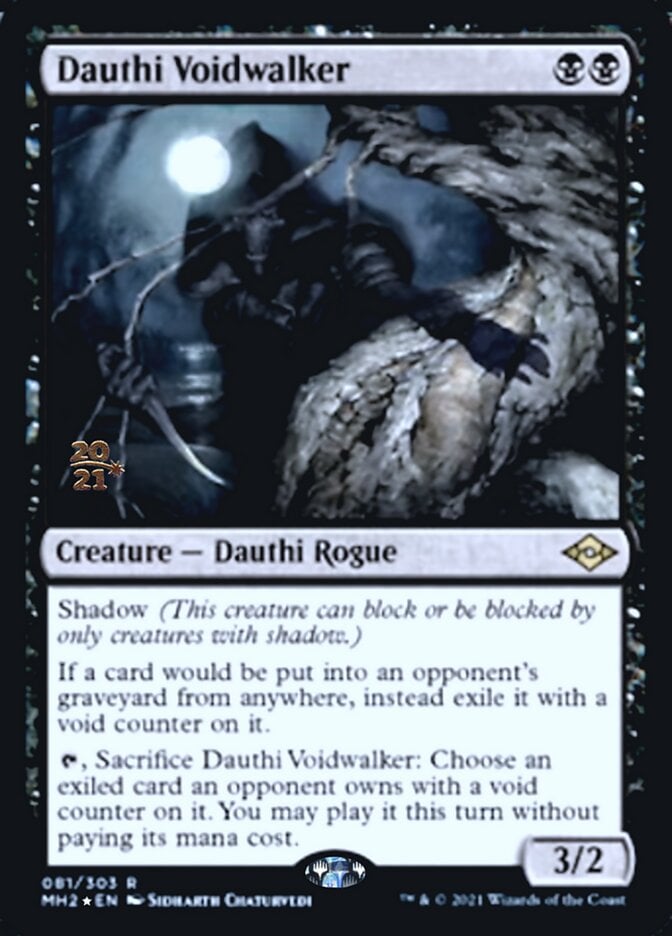
Dauthi Voidwalker is a 3/2 with shadow for two mana, which is basically unblockable given that your opponents are probably not playing shadow creatures. What’s more, it exiles cards from graveyards and you may play one of them for free later. It puts pressure on opponents while messing with their graveyard plans at the same time.
#31. Phyrexian Arena
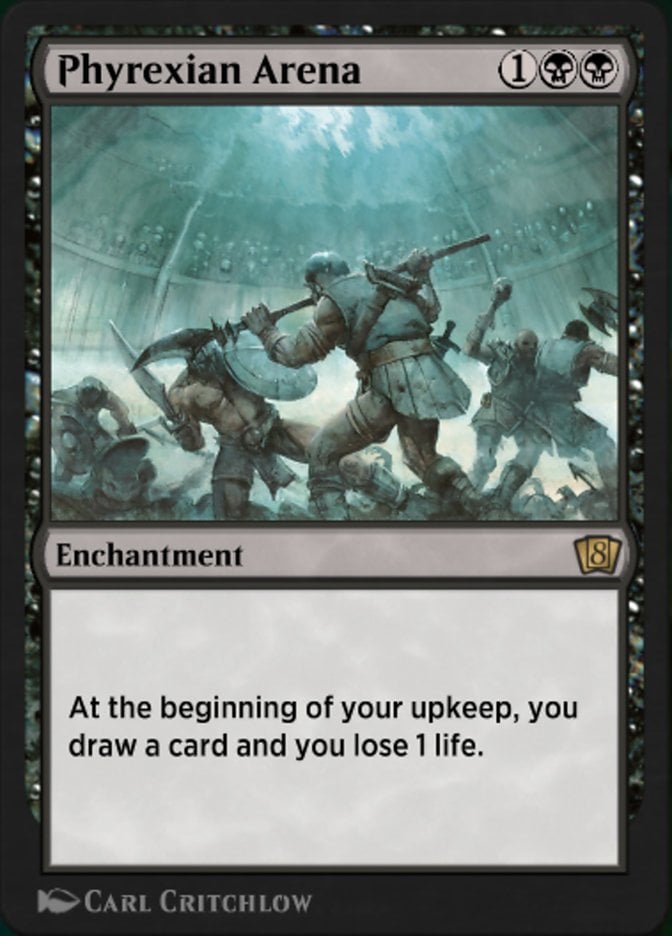
Lots of MTG strategy articles mention that a given card works as a personal Howling Mine since you draw two cards instead of one each turn. Phyrexian Arena is one of those, and you’ll play it whenever your game plan is to get ahead on resources, like to get an edge in mid-range mirrors or to beat control decks.
#30. Deadly Dispute
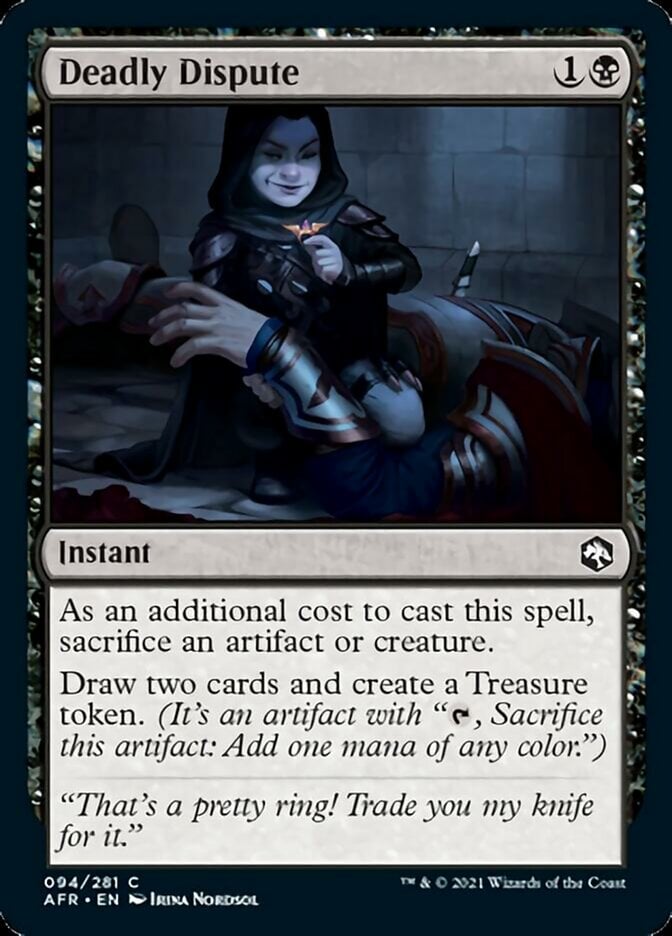
Deadly Dispute allows you to sacrifice a creature or artifact and draw two cards. In grinder formats like Pauper, this card is king, countering removal and interacting with artifact lands. It’s efficient enough that you can play it in Rakdos sacrifice decks in many formats and in EDH artifact-based decks.
#29. Entomb
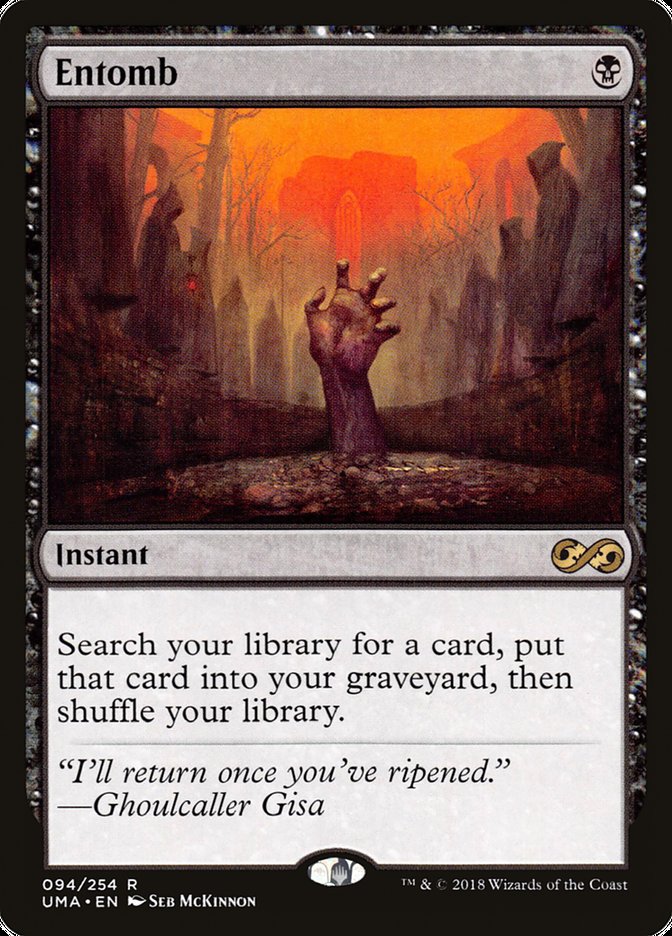
Reanimator decks need a key fatty in their graveyard, and there’s no better card to do the job than Entomb. Having your opponent Entomb for a key card like Griselbrand is scary. There are similar cards like Buried Alive and creatures like Oriq Loremage that do a similar job, but no one’s as mana-efficient as Entomb.
#28. Ad Nauseam
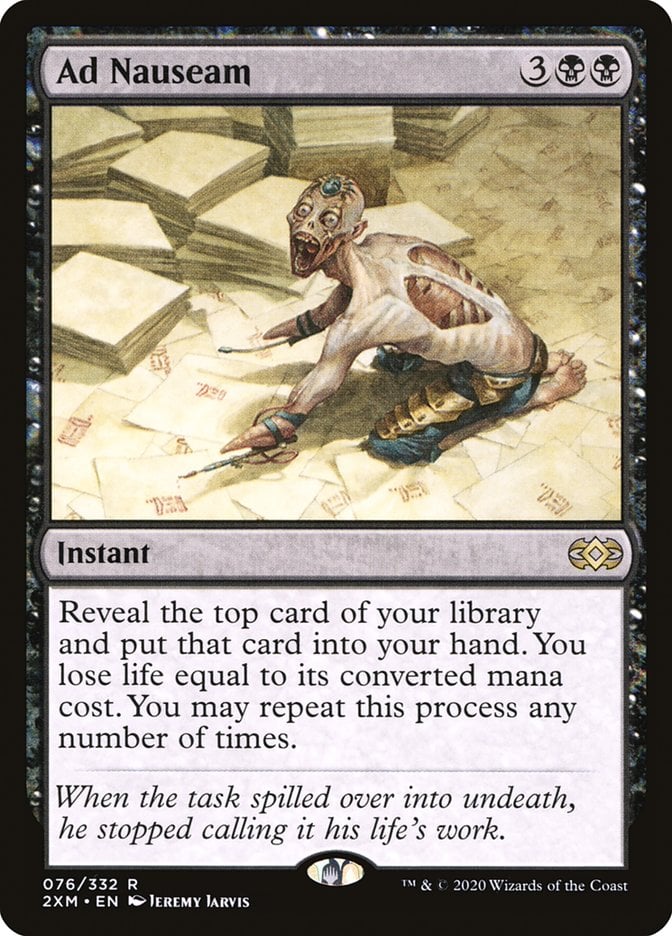
Ad Nauseam is a sure but risky way to draw a bunch of cards in a single turn to find your combo pieces or whatever else you need. In decks like Ad Nauseam + Tendrils, the card is used either to get enough storm count by having free spells or to find your Tendrils of Agony win condition.
#27. Blood Artist
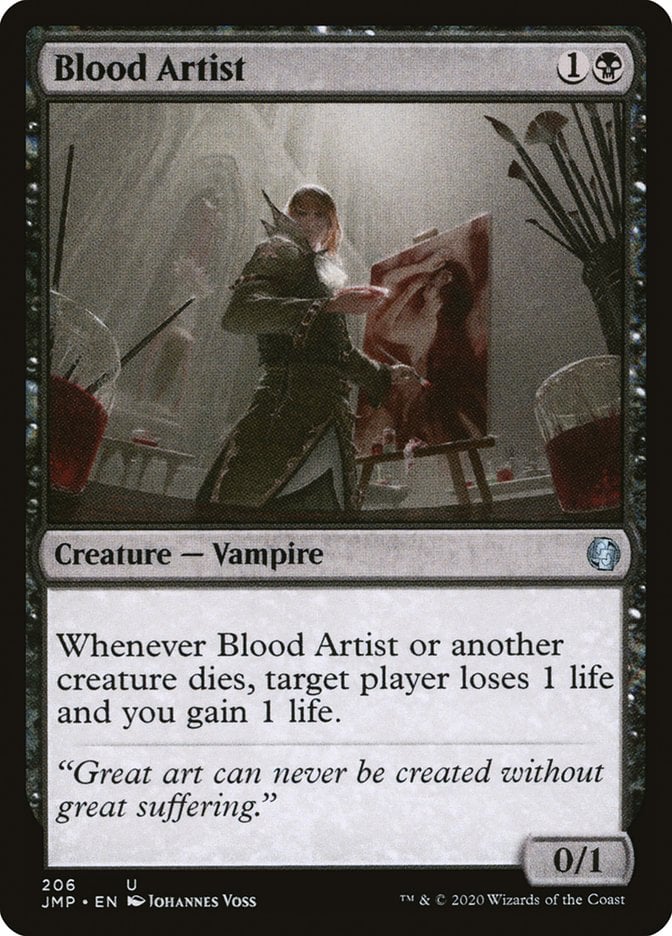
Blood Artist is an aristocrat’s best friend, so to speak. There’s nothing more that you want than to drain people for one mana each time a creature dies, and it doesn’t even need to be your creature. The card is an important source of repeated lifegain triggers for the decks that want it, as well as a win condition.
#26. Torment of Hailfire
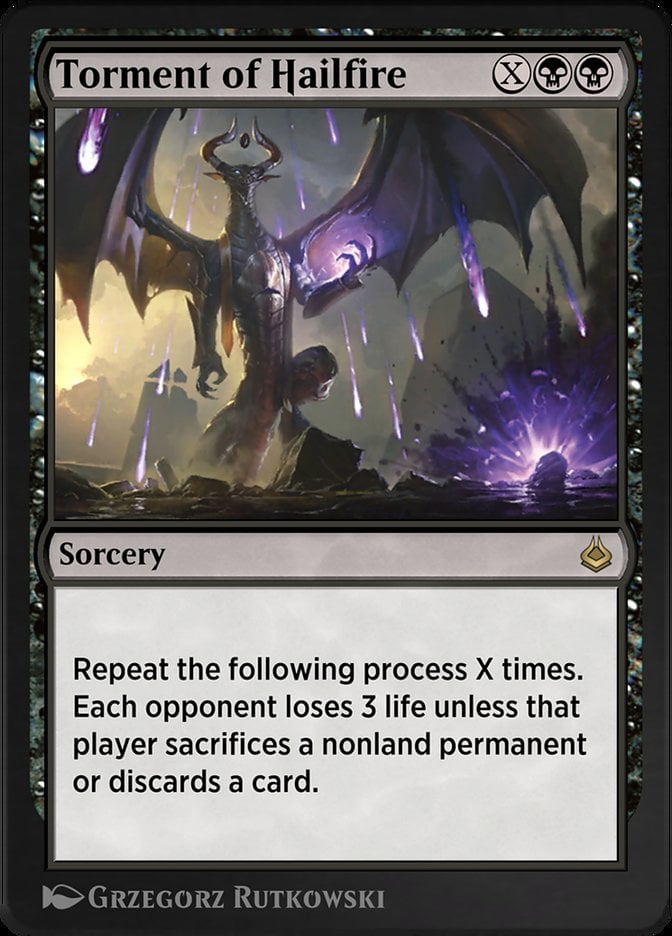
Torment of Hailfire is a way to turn a lot of mana into a win condition. Especially in EDH, since it applies to each opponent. Whatever your infinite mana combo is, Torment of Hailfire finishes the game off. You can even get nice results with excess mana from Cabal Coffers or Nykthos, Shrine to Nyx.
#25. Dark Confidant
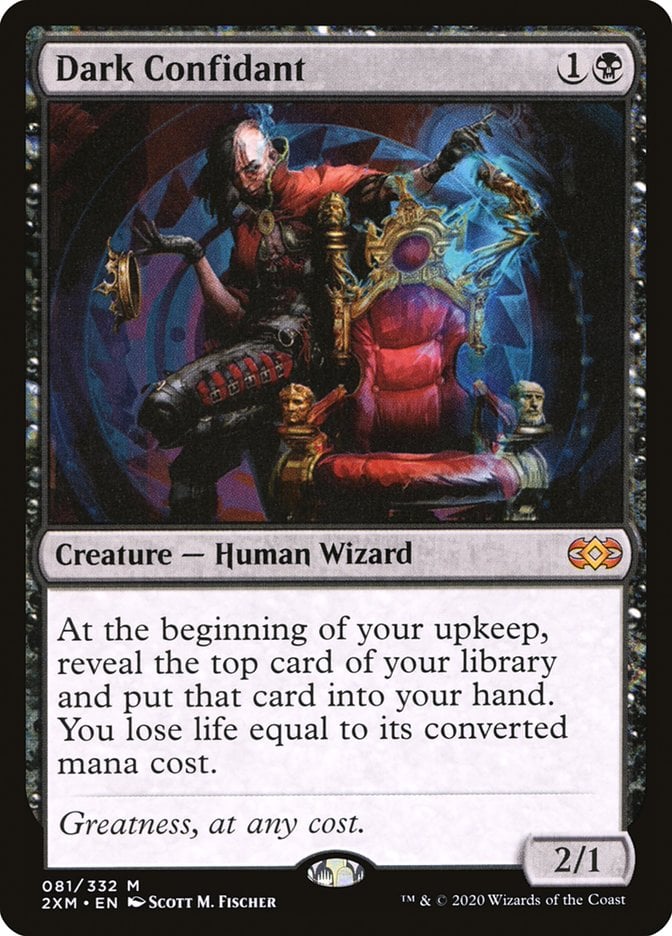
Although it’s fallen from favor, Dark Confidant is a premier 2-drop in black thanks to the ability to draw an extra card on your turns. Power creep and removal spells have quickly caught up with “Bob,” but it’s still a powerful creature and can shine in the right metagame.
#24. Gurmag Angler
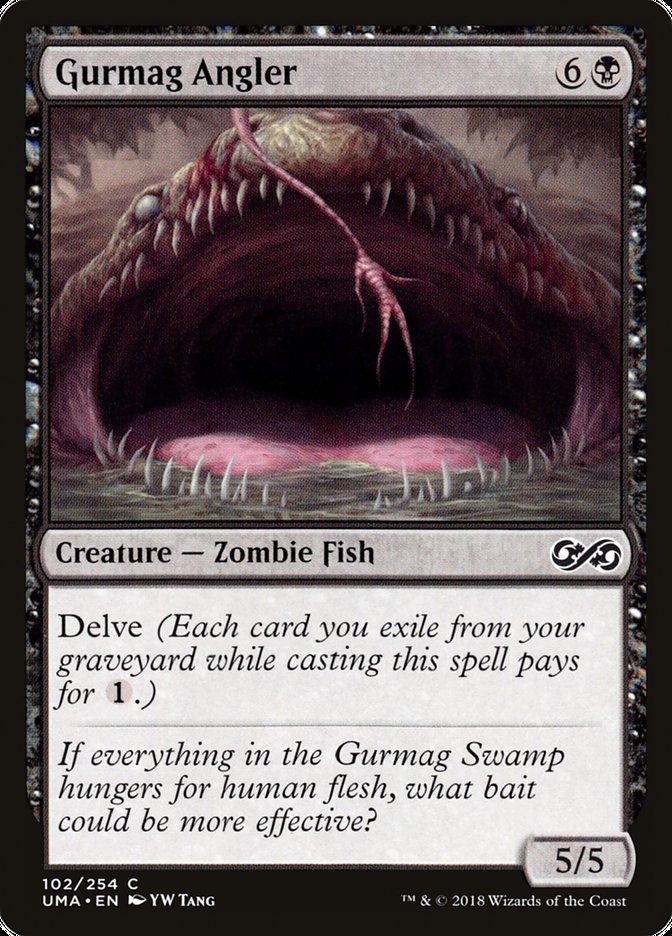
Gurmag Angler is a vanilla 5/5 creature that can be cast for as low as one mana thanks to the delve ability. You’ll usually play Angler in aggressive decks with a self-mill component. Paying three mana for it is already a fine rate; just be wary of multiples in your opening hand.
#23. K'rrik, Son of Yawgmoth
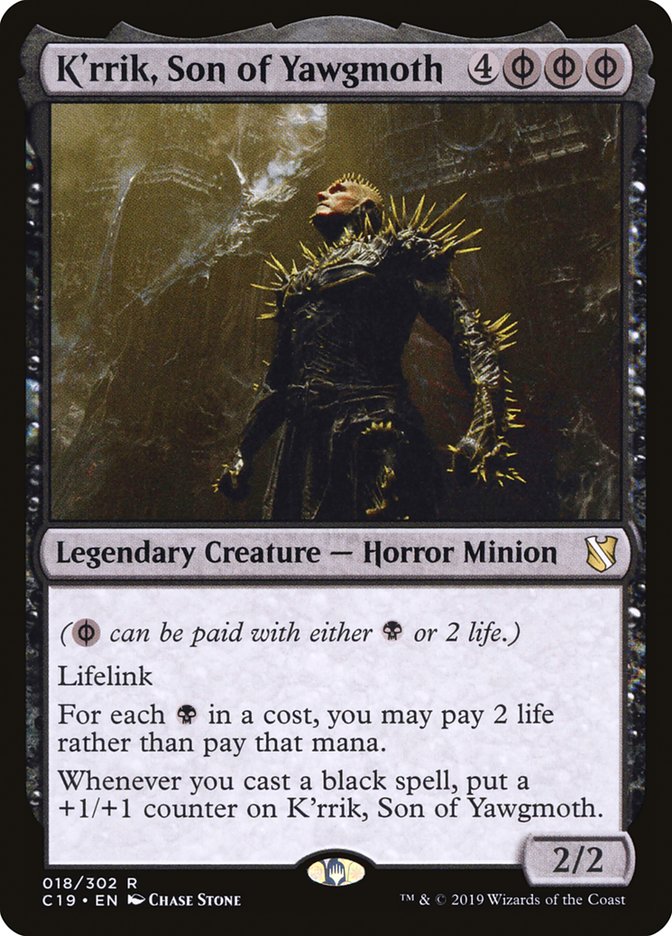
K'rrik, Son of Yawgmoth has a unique ability that makes him a “glass cannon commander.” The main thing with K’rrik is to aggressively spend your life total to cast black spells, which in turn leads to lifegain. You have more life to trade for black mana, repeating the process enough times to win. You may combine, for example, Bolas's Citadel and Aetherflux Reservoir, giving you card advantage and life to offset the life loss, or maybe have reanimate loops using Chainer, Dementia Master and Gray Merchant of Asphodel.
#22. Damnation

Damnation is Wrath of God in black, and the ability to destroy all creatures for four mana is precious in decks like control since you don’t need to splash white for this effect. Black’s got a few sweepers based on toughness, but none of them are unconditional like Damnation.
#21. Bitterblossom
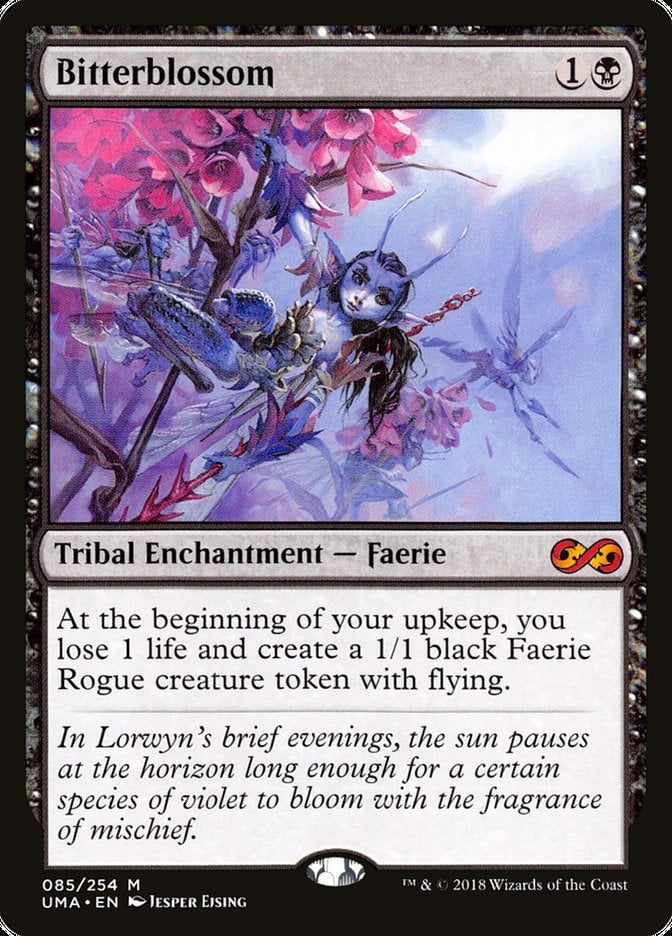
Bitterblossom is like a mini planeswalker with a single activated ability. You can produce a flying 1/1 faerie token each turn and lose a life, and the flexibility of what you can do with it is huge. Bitterblossom can be the base of a faerie tribal deck, add fliers to the board, pressure control decks, and synergize with ninjutsu creatures, all in one package.
#20. Infernal Grasp
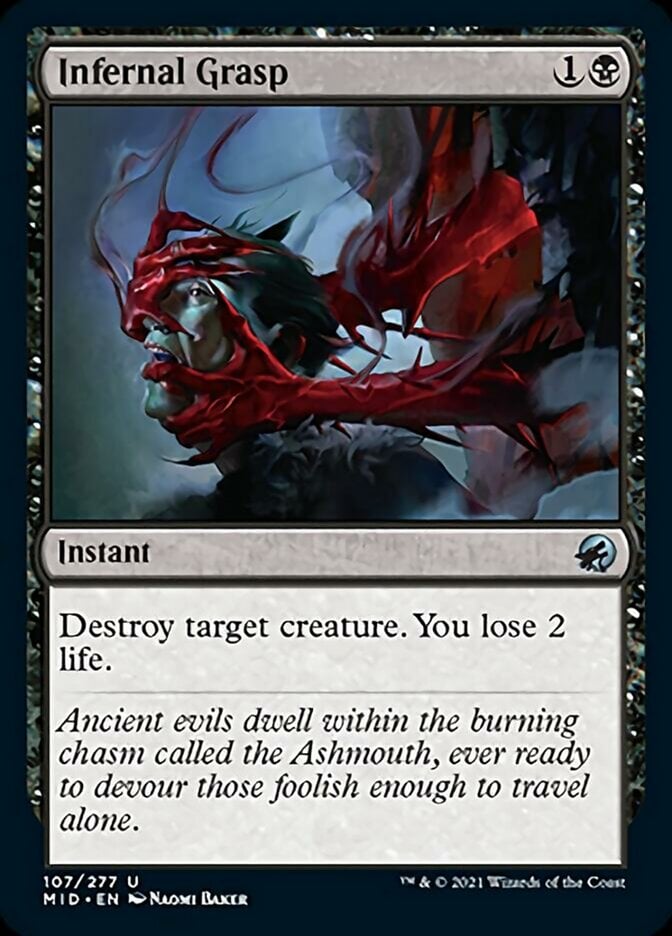
The only 2-mana unconditional creature removal that black has access to, with the low downside of losing two life. Infernal Grasp is, in many ways, a better Murder since you don’t care much about losing life, especially in EDH.
#19. Gray Merchant of Asphodel
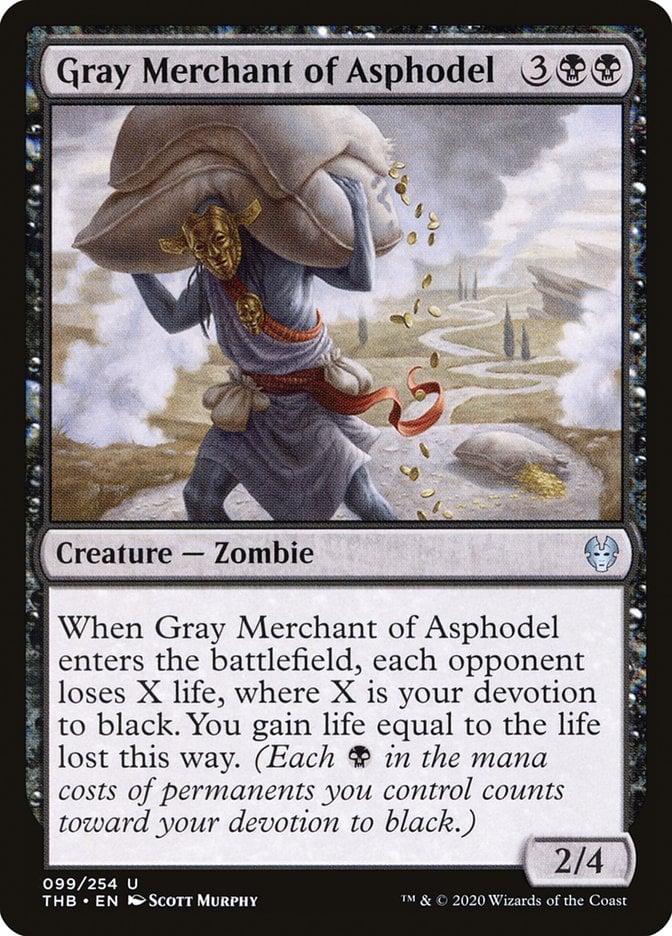
Gray Merchant of Asphodel, or Gary, is a creature that dominated its Standard format. Gary was a reason to run mono-black decks with lots of permanents on board. It gets better in EDH since you’ll drain all the opponents at once. Gary’s best decks are heavy black decks based on life drain synergies or cards like Sanguine Bond and Ayara, First of Locthwain.
#18. Reanimate + Animate Dead
Black is famous for the cheap reanimation effects it provides, and those are among the best. An easy way to get an edge in a game is to pay a single mana to Reanimate a big threat like Grave Titan, even if you lose 6 mana while doing it. Modern MTG asks you to play 4+ mana to bring a creature from the graveyard to the battlefield, so paying only two mana is a huge deal.
#17. Archon of Cruelty
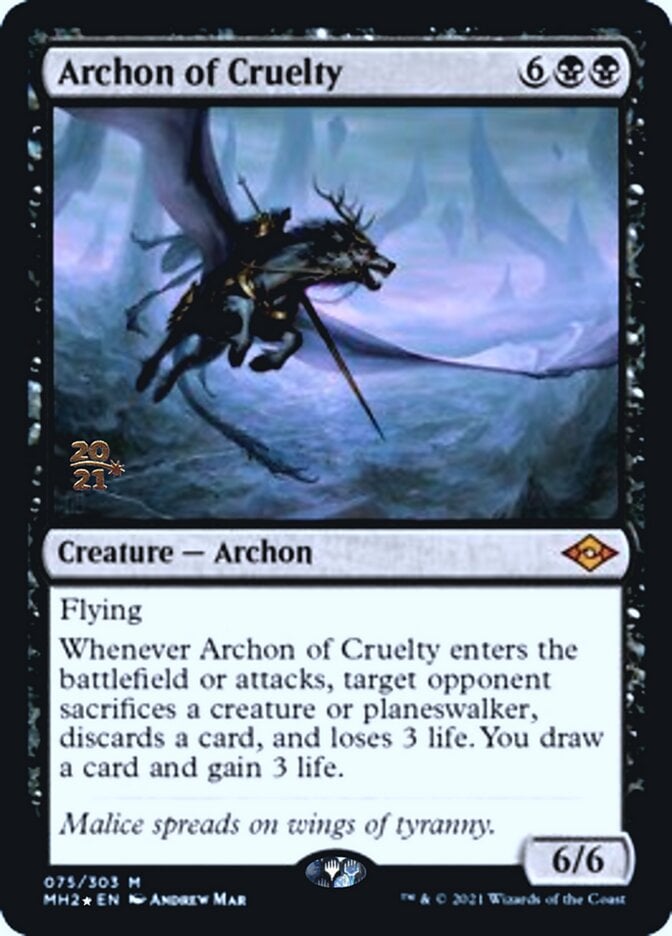
Archon of Cruelty is one of the best reanimation targets printed since Griselbrand. You won’t draw 7 cards like Griselbrand does, but if your deck needs variety in reanimation targets, go for it! Archon generates card advantage and impacts the board when it ETBs or attacks, just like the Titan cycle.
#16. Yawgmoth, Thran Physician
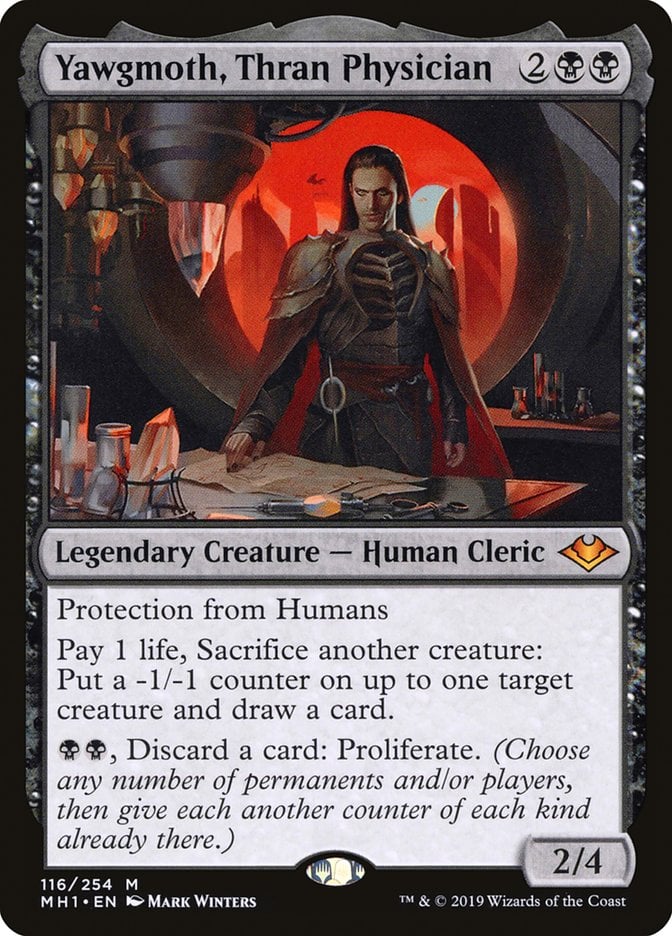
Yawgmoth, Thran Physician is a very popular commander since you have lots of small abilities that combine to make a very attractive package. It’s a free sacrifice outlet in decks like aristocrats that want it, and it can proliferate, draw a bunch of cards, and remove small creatures all by itself.
#15. Hymn to Tourach

There’s a reason WotC doesn’t print “discard at random” effects anymore, and that’s because it’s very frustrating to play against. Hymn to Tourach is efficient because your opponents can’t choose what they’re discarding, so they can’t get rid of the worst cards from their hand. You’ll see it played the most in Legacy and Cube, since the effect doesn’t scale that well in EDH. In Modern, the closest you can get is the kicker on Tourach, Dread Cantor which is a reference to this card.
#14. Grave Titan
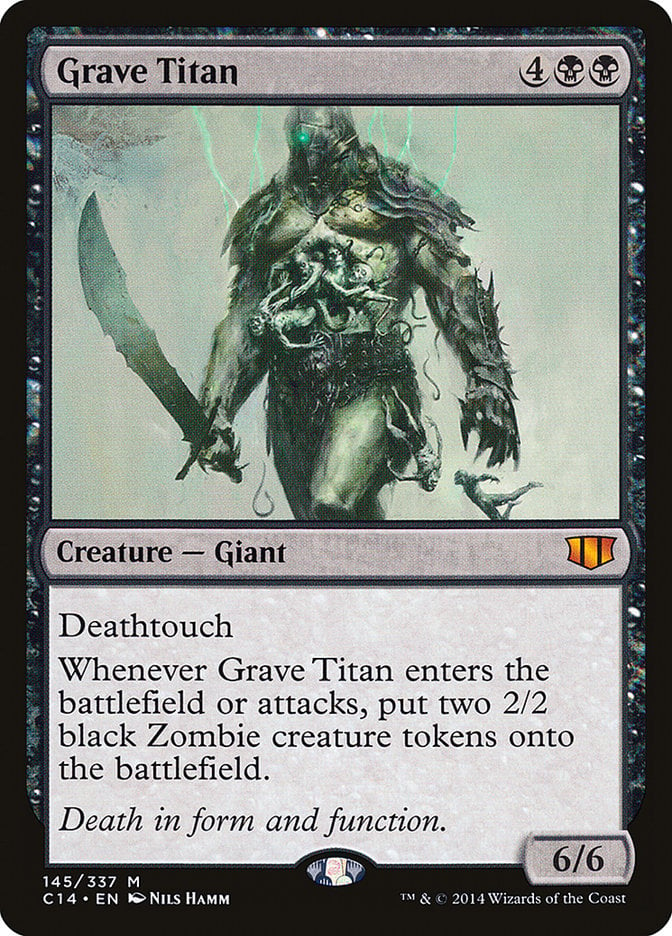
The Titan cycle deserves a top spot among MTG’s most powerful cards., and Grave Titan is no exception. Cast it to get a 6/6 deathtouch alongside two 2/2 zombie tokens, a 10/10 worth of stats alone. Each time it attacks, you make more zombies. It’s one of the best black creatures to play in a zombie tribal deck since you get lots of zombie creatures and stats in a single package, and it’s a good card to play in midrange and recursion decks.
#13. Dismember

Technically a colorless mana, since you can pay the black mana with two life, Dismember does a few things right. Even in black decks, you can cast it for less than three mana when needed. It gives a creature -5/-5, so it gets around indestructible and can shrink bigger creatures. Add to it that you can play removal in a mono blue deck and you get a hell of a card.
#12. Fatal Push
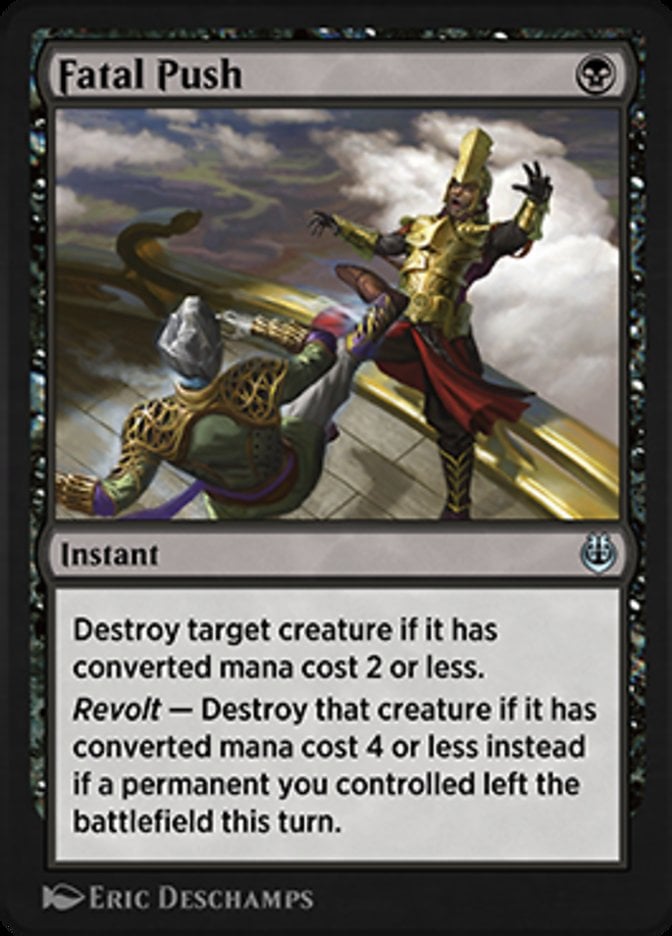
Fatal Push has changed what a 1-mana black removal spell can do. You can destroy any creature with a MV of 2 or less, and together with fetchlands, you can kill any creature with a MV of 3 or 4. Black didn’t have a cheap and reliable removal spell like Lightning Bolt or Path to Exile before, but it has now thanks to this card.
#11. Dark Ritual
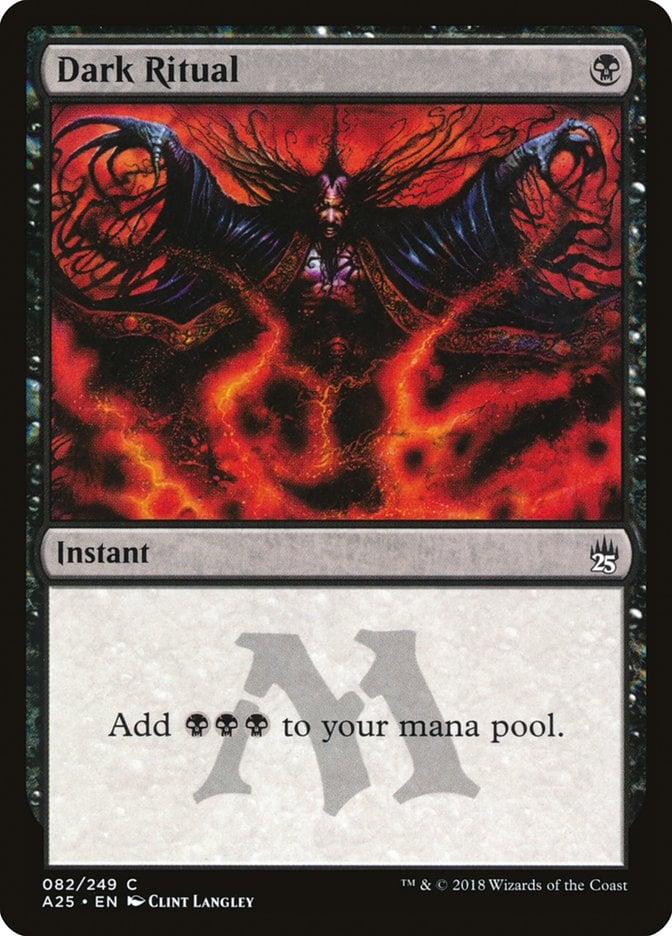
Generating three mana for the cost of one seems innocuous at first, and Dark Ritual is card disadvantage. The ramp effect it provides is really powerful though. It was used it MTG’s early years to play 3 and 4 MV cards ahead of time, but now the main application is in storm engines to generate enough mana to play a card like Ad Nauseam or Dark Petition.
#10. Griselbrand
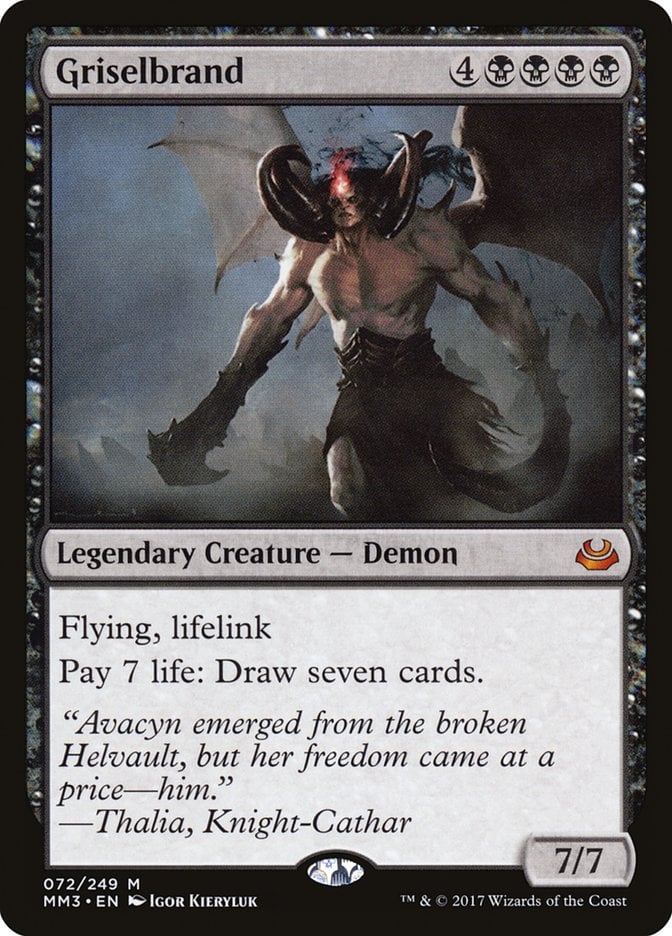
Griselbrand is at the top of the possible reanimation targets. Reanimate it to draw 7 or maybe 14 cards in a single turn. With so many cards in hand, it’s fairly easy to cast some rituals and some free spells to win. Not many cards allow you that much quick power, and it’s easy to label Griselbrand as one of the best creatures ever, although restricted to reanimator decks since you’re not casting or ramping it.
#9. Liliana of the Veil
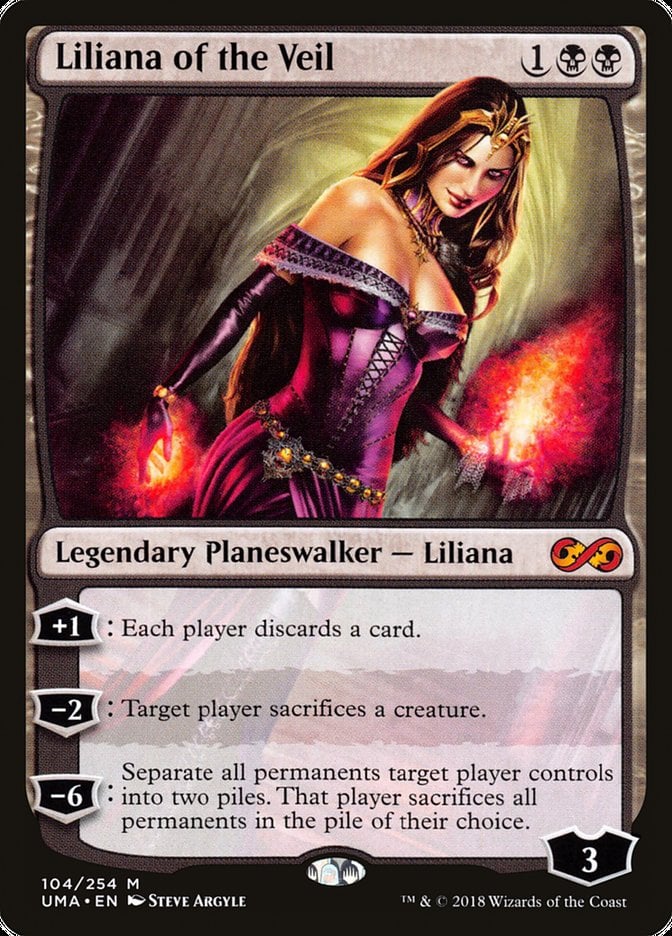
Liliana of the Veil is one of the best planeswalkers and probably the one that sees the most play in Constructed across all formats. It’s a powerful two-turn play via mana accelerants, its +1 activation attacks your opponent's hand, and alternating between the discard ability and the sacrifice ability generates a lot of resource advantage. The most important thing to have in mind when playing “Lili” is that you’re usually empty-handed since your cards are cheap or have diminishing returns in the late game like discard effects or lands. The way you win is either by supporting your attacking creatures or ultimating Liliana.
#8. Grief
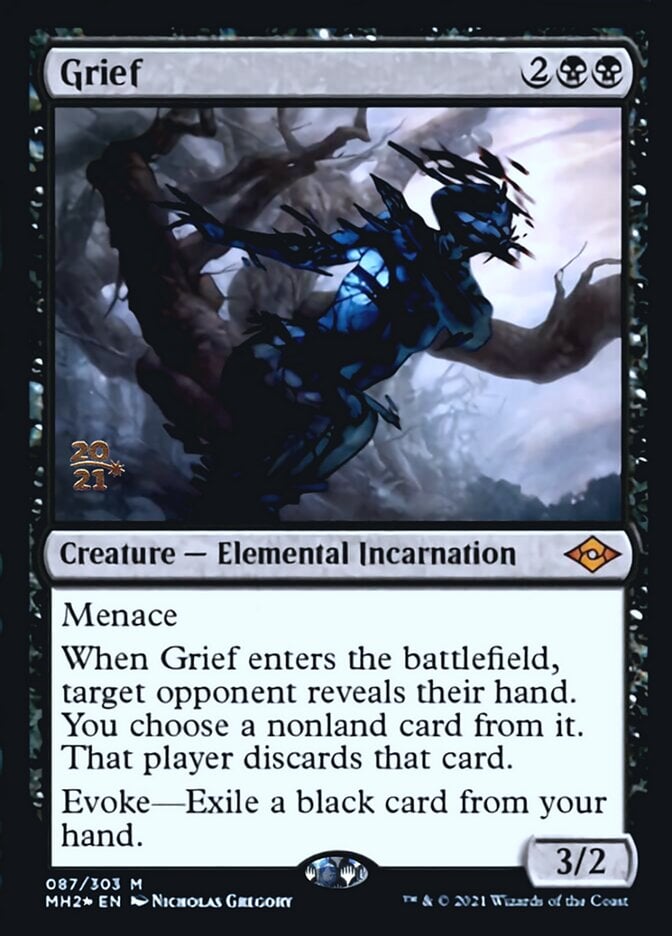
Grief is basically a 3/2 menace that has a discard effect attached. Like in all the Modern Horizons 2 elemental cycle cards, you can evoke it by pitching a black card to quickly disrupt an enemy without spending mana. The real power of cards like Grief comes when you combine it with blink effects like Ephemerate, which allows you to get two ETB triggers and keep the card.
#7. Sheoldred, the Apocalypse

When I first saw this card, I didn’t think it’d have that much impact. After playing with and against the card, I quickly realized how much of a powerhouse Sheoldred, the Apocalypse can be. It’s very flexible in what it can do for a given deck, whether stabilizing the board, contributing to lifegain triggers, or dealing more damage to opponents in aggressive decks. It quickly became one of the more popular black commanders with thousands of lists posted online, and one of the most played black creatures in formats like Standard and Pioneer.
#6. Toxic Deluge

Toxic Deluge fits the bill of a cheaper and more flexible/effective sweeper. For only three mana, you can kill anything, ranging from a Damnation to a Plague Wind. You’ll tune the sweeper by paying life, so you can allow your 4/4 to live while killing small creatures only, which you can’t do with sweepers like Mutilate or Wrath of God.
#5. Yawgmoth’s Will
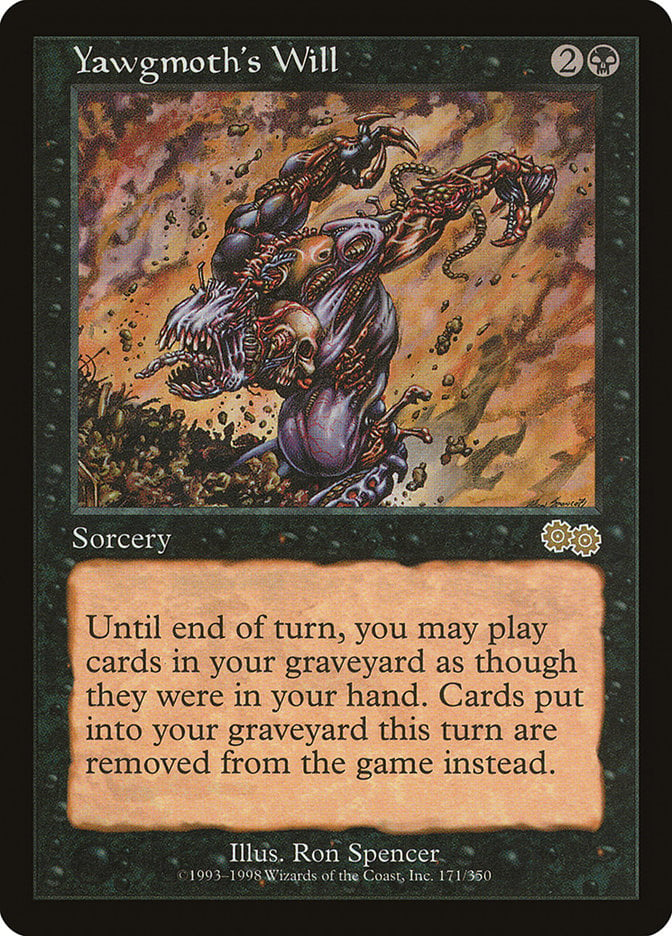
Yawgmoth's Will provides a ton of card advantage by allowing you to replay the cards in your graveyard once more. In storm decks, this is a much-needed effect since you need spell redundancy and a big combo turn. It’s usually best paired with Dark Ritual or Lotus Petal since they’re cheap effects that generate mana and raise the storm count. It’s not rare to win shortly after you cast this card.
#4. Necropotence
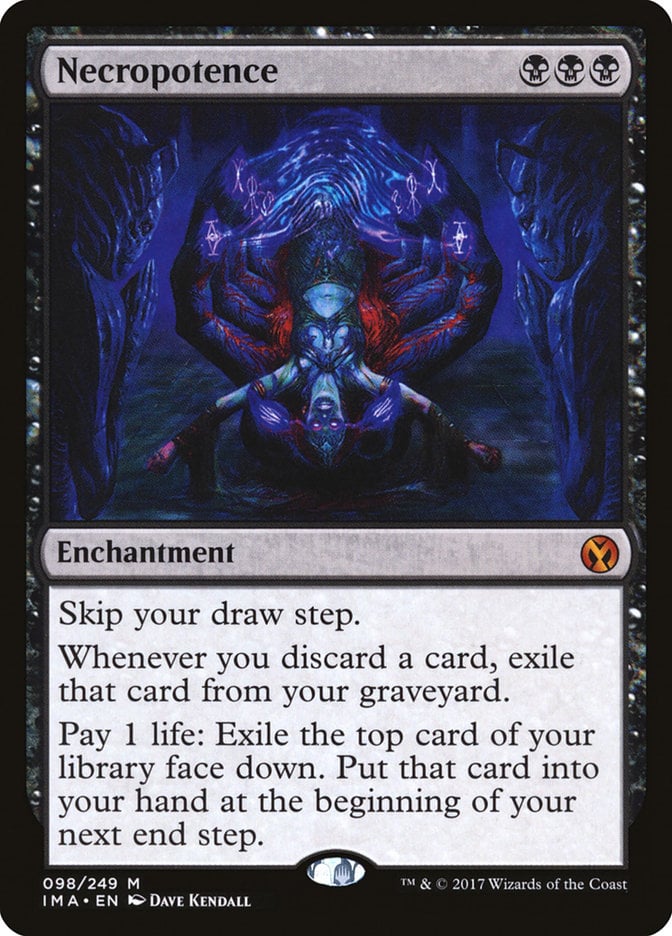
This card took a while for competitive MTG players to realize how utterly broken its effect is. When Necropotence decks got traction, they quickly became the best option by far. For just three mana, the Necropotence player can lose a lot of life in a single turn to draw a bunch of cards, an effect that’s precisely what combo decks are looking for.
#3. Thoughtseize
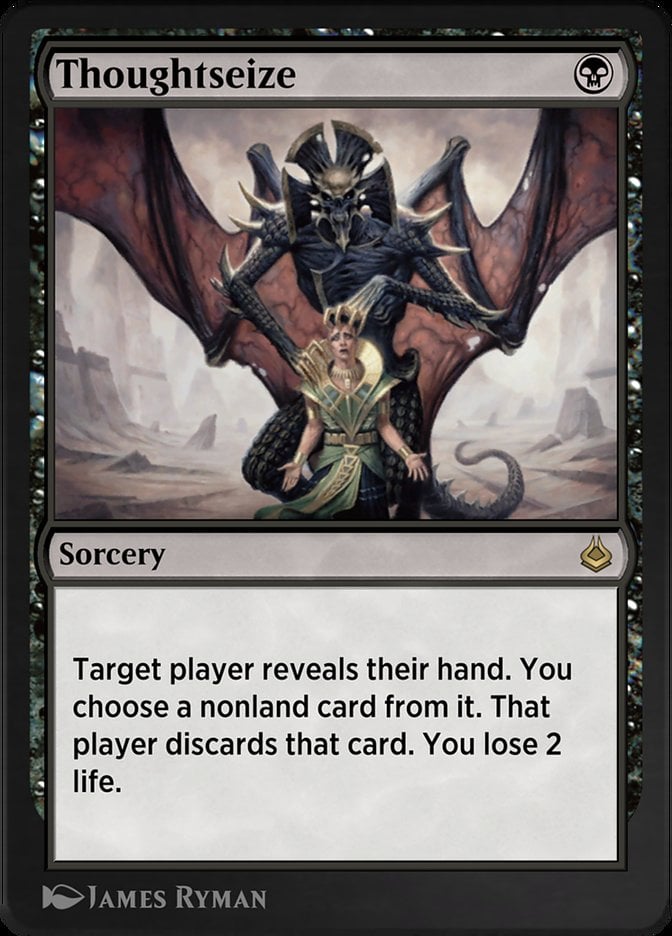
Thoughtseize is the most played discard spell because it costs a single mana and the effect is unconditional, unlike its brethren Duress and Inquisition of Kozilek. The loss of life is acceptable, but it can be a liability when facing aggro and burn decks. Even with the downside, the benefit you get from information and making them discard a key spell is worth the life loss, and control/combo decks hate to see this card at the other end of the table.
#2. Vampiric Tutor
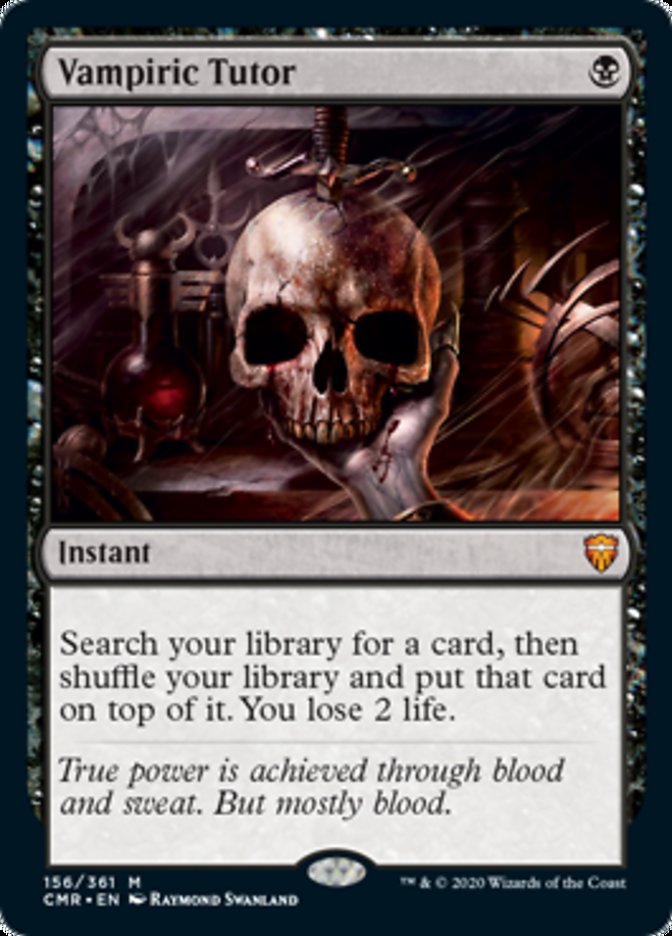
Vampiric Tutor is the best instant speed tutor and can be cast for only one mana, but it has a little downside: you don’t put the card directly in your hand. It’s commonly used together with Sensei's Divining Top so that you can draw the card you just tutored. Being able to get any card you want is essential to combo decks, especially in singleton formats like cEDH.
#1. Demonic Tutor

Demonic Tutor can get you any card from your deck without any card disadvantage or life payment. WotC realized since the beginning of the game that this was a very powerful effect to print, and because of that tutors are very scarce. You either pay more than two mana or put the card on top of your library to draw it on your next turn. The flexibility of paying two mana to get one of your combo pieces and potentially win is what puts this tutor at the top of the list.
Best Black Card Payoffs and Synergies
Black in MTG is a color that works well with itself. This is done by MTG designers to show that the color is corporatist and selfish, and black is one of the colors where these definitions best apply. A good reason for going mono black is that black can cover almost all bases well (except artifact destruction). Here are some incentives for it:
Cards like Corrupt, Cabal Coffers, Mutilate, and Defile want you to play as many Swamps as possible, so their efficiency is maximized in mono-black decks. Or make sure your dual lands are shocks, or lands with the Swamp type.
The devotion mechanic is really strong in black with payoffs like Gray Merchant of Asphodel and enablers like Phyrexian Obliterator, Ayara, First of Locthwain, and Phyrexian Arena, just to cite a few.
Lifegain and life drain is a feature that many black enchantments have, like Sanguine Bond. Whenever you gain life, your opponents lose that much life. It’s often used in sacrifice strategies with Blood Artist or Zulaport Cutthroat, or with commanders like Vito, Thorn of the Dusk Rose.
What Is Black Good at in MTG?
Among the effects that stand out the most in MTG's black portion of the color pie are creature removal spells, tutor effects, targeted discard effects, and explosive mana generation through rituals. This is why cards like Doom Blade, Thoughtseize, and Dark Ritual are so iconic and integral to MTG Constructed.
Tutors like Demonic Tutor and Vampiric Tutor are essential for assembling your combo pieces in older formats like Legacy and Vintage, as well as cEDH.
In multicolor decks, black typically plays a support color role offering creature removal to colors that don’t have access to it like blue and green. Black complements white in card advantage and creature recursion and adds to red’s aggressiveness with life drain effects and unconditional removal.
Black has powerful planeswalkers that generate resource advantage and the ability to trade cards for life, which are traits that midrange decks appreciate very much. Think of cards like Read the Bones, Sorin, the Mirthless, and Liliana of the Veil.
Reanimation is a third black trait, with cards like Entomb, Griselbrand, and Animate Dead.
Let's also highlight the potential to do completely unfair and broken things like drawing dozens of cards from Necropotence or Yawgmoth's Bargain. That, or being able to recast all your cards from your graveyard via Yawgmoth's Will.
Wrap Up

Grief | Illustration by Nicholas Gregory
Black is the color of selflessness and ruthlessness, a color whose cards reflect the extremes of what someone is willing to do to achieve their goals. It’s often mistaken for evil, which indeed many black cards are. To match the game’s flavor, this ruthlessness translates into kill spells, zombie hordes, and demonic pacts.
The best black cards list reflects that black has always had its share of powerful cards alongside MTG’s history, be it powerful Alpha cards like Dark Ritual and Demonic Tutor or more recent cards like Grief and Archon of Cruelty.
What about you, black mages? Are you more of a “kill everything in sight” player or a “tutor your combo” player? What didn’t make the list? Let me know in the comments below or over on Draftsim’s Twitter.
Stay safe, folks, and thanks for reading!
Follow Draftsim for awesome articles and set updates:
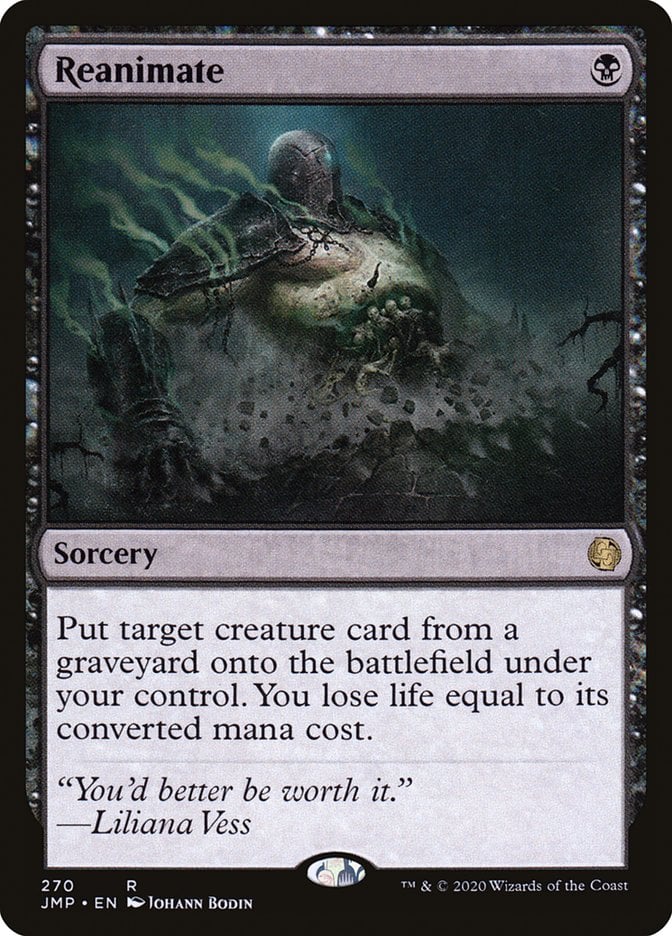
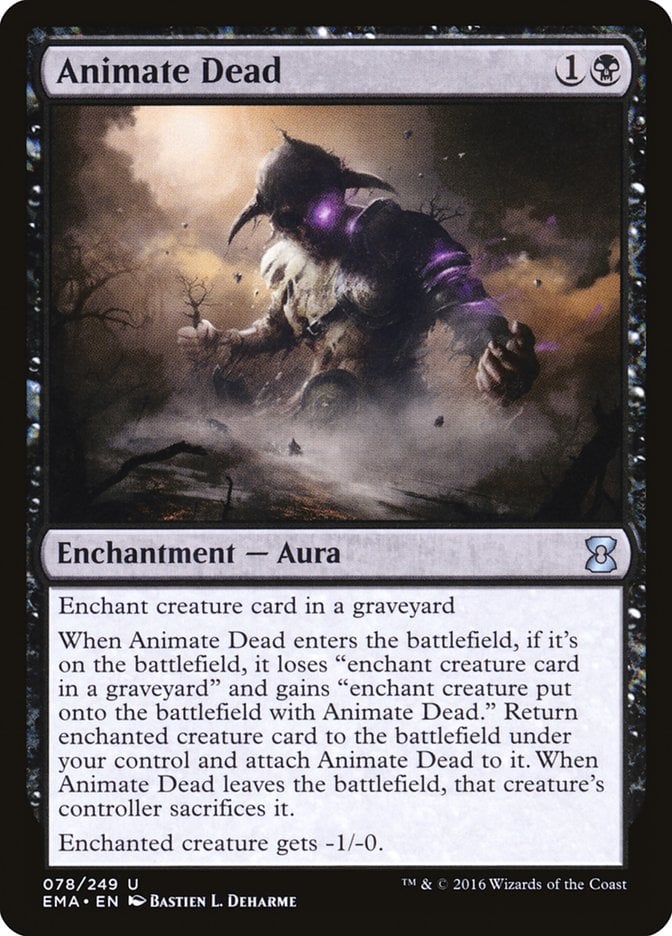
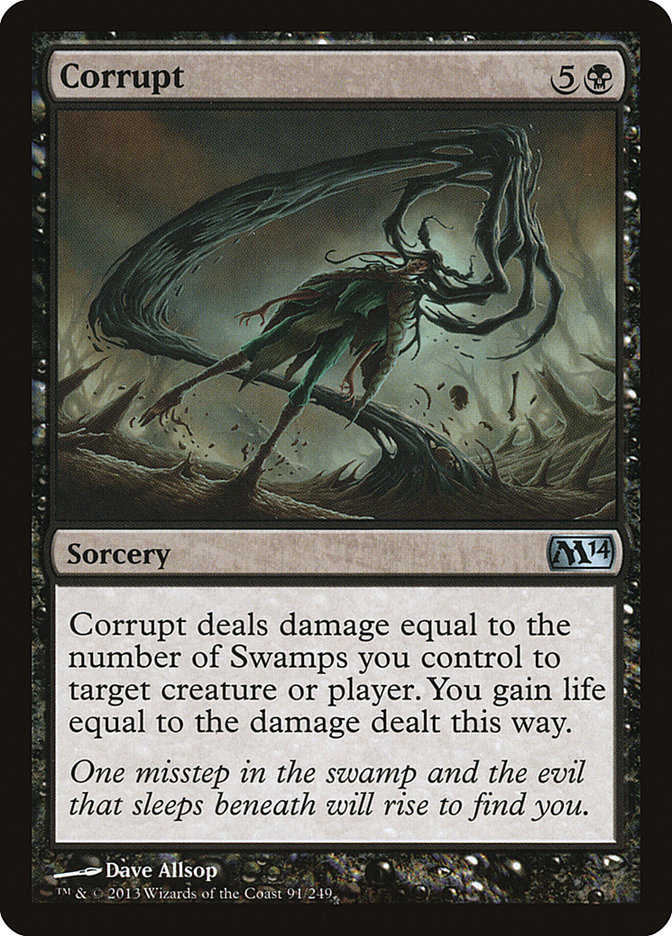
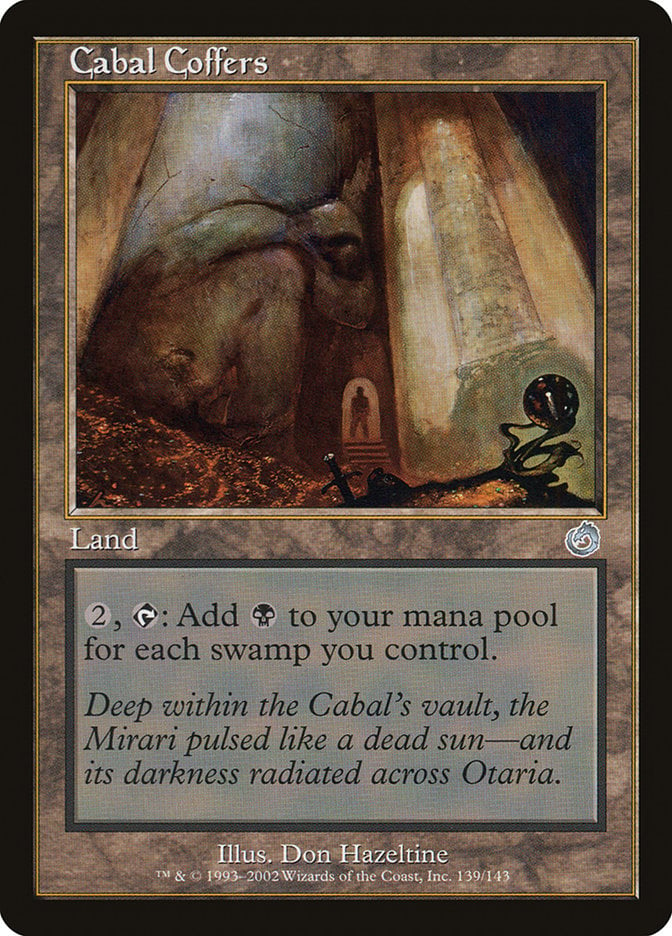
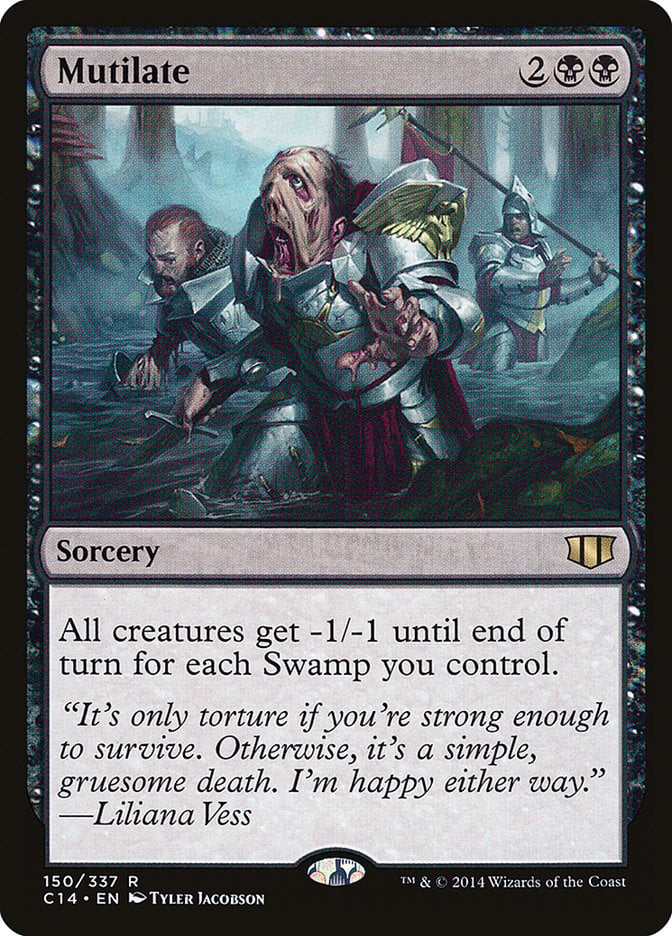
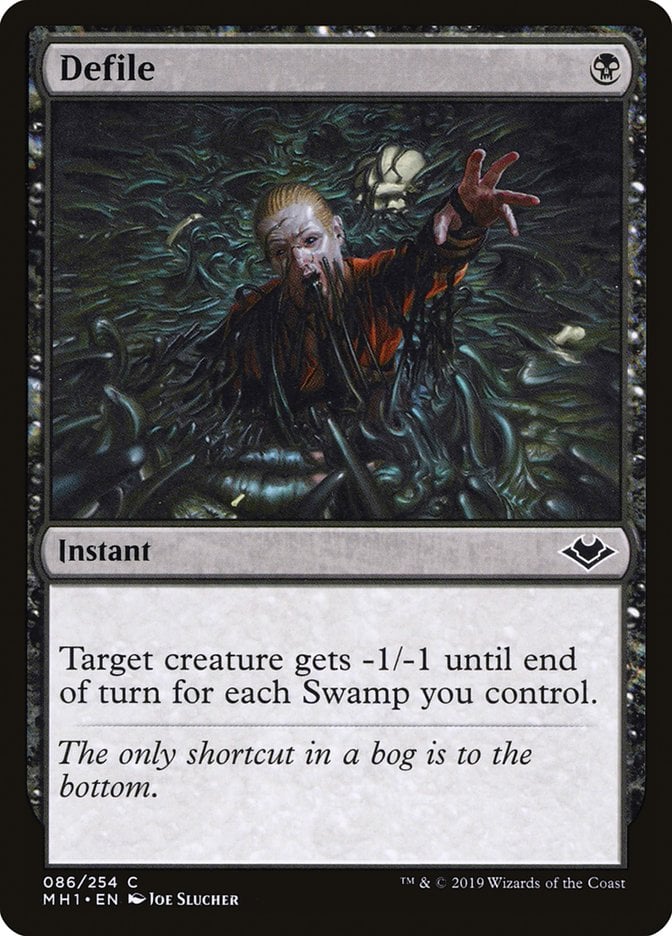



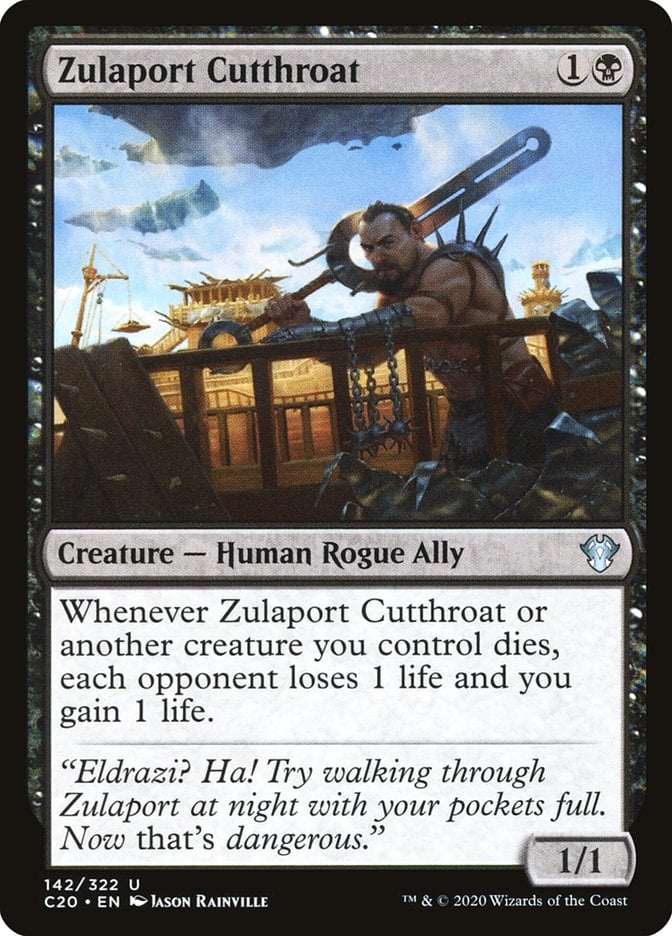
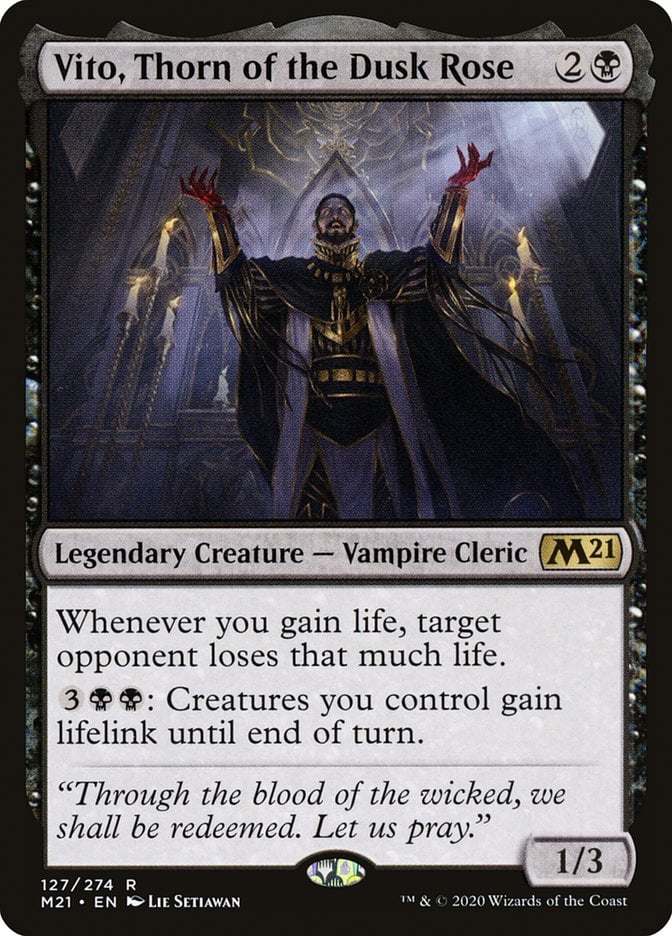
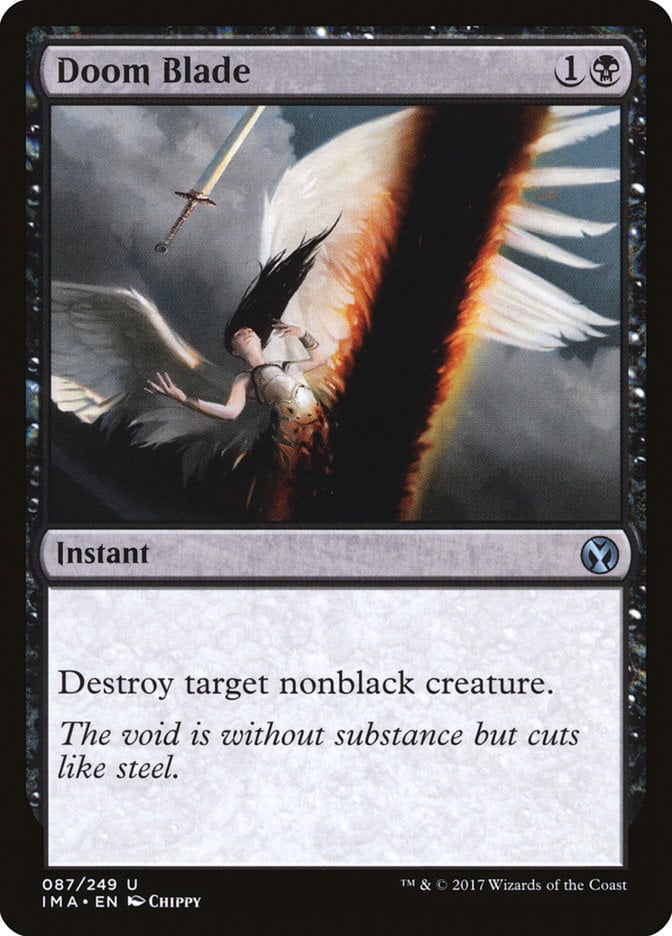


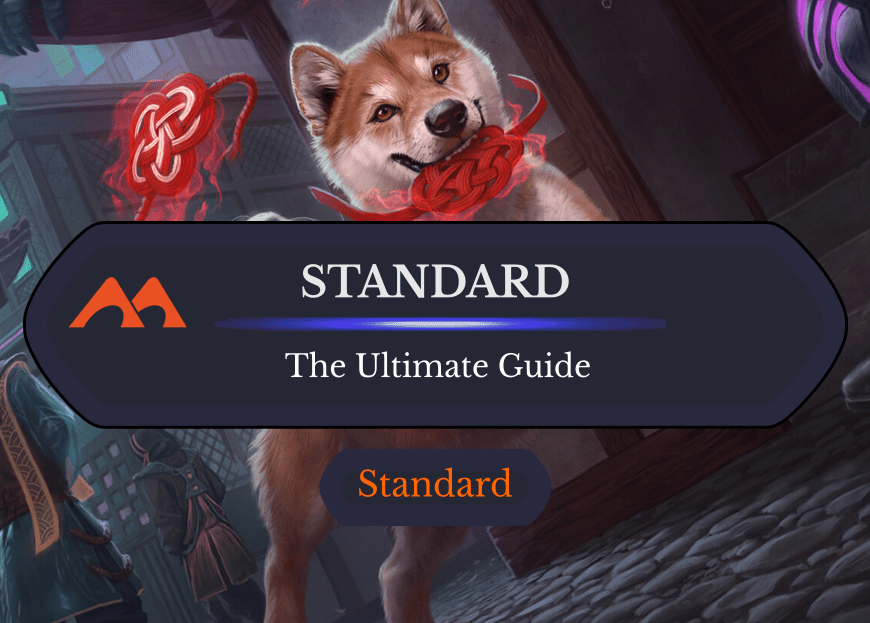

1 Comment
great read; love mono-black.
Add Comment